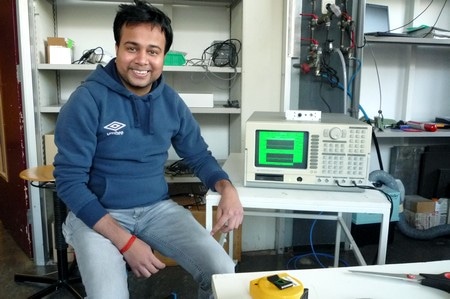Oct 18 2019
To manufacture transistors that work using the spin of electrons, instead of their charge, it is essential to discover a way of turning spin currents on and off. Moreover, the period of the spins should at least match the time taken for these electrons to pass via a circuit.
 Siddharta Omar | Photo Science LinX
Siddharta Omar | Photo Science LinX
A team of scientists from the University of Groningen has recently taken a crucial step forward by building a device that matches both of these requirements, based on a double layer of graphene atop a layer of tungsten disulfide. Details of the research have been published in the October 16th issue of the journal Physical Review B.
Graphene, a two-dimensional (2D) form of carbon, is an exceptional conductor of electron spins. However, it is hard to control spin currents in this material. Spin can be defined as a quantum mechanical property of electrons, which makes them act like miniature magnets.
The Physics of Nanodevices group at the University of Groningen, led by Professor Bart van Wees, is working to overcome this problem. They have earlier demonstrated that it is possible to manipulate spin currents if the graphene is positioned on top of a layer of tungsten disulfide (another 2D material).
New technique
However, this approach reduces the lifetime of the spins.
Siddhartha Omar, Postdoctoral Researcher, Van Wees Group, University of Groningen
Tungsten is a metal, and its atoms impact the electrons traveling through the graphene, dispersing the spin currents. This steered Omar to add a double layer of graphene on the tungsten disulfide, based on the concept that electrons traveling through the upper layer should “feel” less of the metal atoms’ effect.
Omar also used another new method, wherein two diverse types of spin current are conveyed through the graphene. Spin is a magnetic moment that has a set direction. Spins in regular materials are not aligned. However, the magnetic moment of spin currents—similar to that of magnets—has a special alignment. Relative to the material via which the electrons are traveling, their spins can either have an out-of-plane orientation or an in-plane orientation.
Energy level
“We found that, as the electrons pass through the outer graphene layer, the in-plane spins are dissipated very quickly—in mere picoseconds. However, the lifetime of the out-of-plane spins is about one hundred times longer.” This means that, even when exposed to tungsten disulfide, one component of spin currents (spins with an out-of-plane coordination) can move far enough to be employed in devices like transistors.
The energy level of the spin currents witnessed by Omar caused them to travel via the upper layer of graphene. This energy level can be improved by applying an electric field, forcing the spin currents into the lower layer.
Down there, the spins will feel the full effect of the metal atoms and the spin currents will quickly dissipate.
Siddhartha Omar, Postdoctoral Researcher, Van Wees Group, University of Groningen
This capacity to turn the spin current off using an electric field is significant, as it could be applied to “gate” transistors based on this technology.
Unfortunately, certain technical limitations of the substrate on which we built these devices prevent us from creating electric fields that are strong enough to produce this gating effect. However, we have shown that it is possible to send spin currents through a heterostructure made of graphene and tungsten disulphide. That is an important step towards the creation of a spin transistor.
Siddhartha Omar, Postdoctoral Researcher, Van Wees Group, University of Groningen